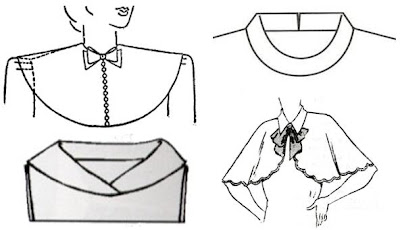The groups delivered PowerPoint presentations. Pictures were required, but we did not need to bring in any samples. My group’s presentation included flats and photos. Sewing a few collars would have been fun, but if I had been in the jackets group I would have been a lot happier about not needing to make samples.
There were eight people in my group. We each had a few collar types to research. Mine were bertha, mock, cape, and portrait. The bertha collar is a round flat piece of fabric that extends over the shoulders. A mock collar is a neck facing that extends over a top’s neck opening so that it appears to be a collar. A cape collar appears like a small cape worn over the shoulders. A portrait collar is made with two broad pieces extending from the neckline that lie flat against the body and overlap at center front.
 The PowerPoint presentations had to be loaded onto the instructor’s computer to use in class. I uploaded my group’s file, which gave me an opportunity to add one extra slide. It is not apparel, but the design process is the same. Many Stout apparel design graduates go to work for Kimberly-Clark designing diapers and incontinence pads, so I figured a cervical collar would be OK. But mostly I inserted it for comedic value. The class thought it was funny, and the instructor appreciated it too.
The PowerPoint presentations had to be loaded onto the instructor’s computer to use in class. I uploaded my group’s file, which gave me an opportunity to add one extra slide. It is not apparel, but the design process is the same. Many Stout apparel design graduates go to work for Kimberly-Clark designing diapers and incontinence pads, so I figured a cervical collar would be OK. But mostly I inserted it for comedic value. The class thought it was funny, and the instructor appreciated it too.

